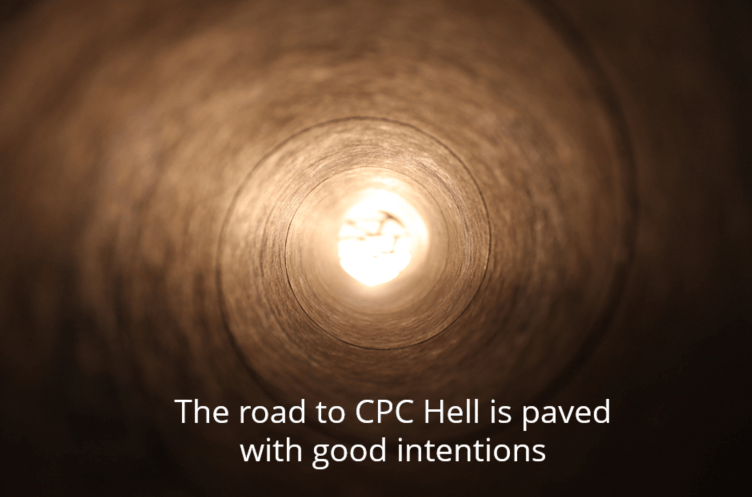Branded campaigns (i.e. targeting your brand and product names on search) are not lead gen campaigns. Branded campaigns are defensive campaigns. Their purpose is to push down competitor ads and force competitors to pay more when targeting your customers and prospects. Your goal isn’t to hit below a target cost per opportunity; your job is to determine what activities generate brand searches and attribute your branded opportunities to those activities. In the meantime, stop spending so much targeting your brand.
Seeing accounts where advertisers are paying north of $30 to target their own brand is stomach churning. Companies earn branded traffic through hard work. You should be agitated if you’re allocating a significant investment to target your brand.
Increasing bids on branded terms is a slippery slope. Upping your bid from $1 to $2 per click then $5 per click and eventually $25 per click happens with good intentions. Advertisers see their position slip from 1.1 to 1.5, or a HiPPO runs a search and sees a competitor ad above organic results. Demands to be in first position come down from the top, or Google’s tantalizing top position bid estimate illuminates a higher bid. All of a sudden, you’re paying $12 for a click from someone searching for your homepage.

What makes it more difficult is branded campaigns drive a substantial number of opportunities, and digital marketers cannot help themselves. We need to take credit for pipeline from brand terms. Cost per opp (CPO), pipeline to spend, and ROI never look as exciting with contributions from branded campaigns omitted. So, we justify increasing bids on branded terms. CPA, CPO, and every other acronym still looks good compared to other campaigns.
In reality, branded campaigns are unique. They are tied to trade shows, water cooler conversations, Magic Quadrants, and cold emails. The expense is hidden for the most part. A cost per opportunity of $500 from a branded campaign could actually be due to a $20,000 billboard buy. Branded campaigns should be reported on separately with a couple clear goals:
- Minimize costs while defending your brand terms from competitors
- Determine what activities are driving your brand searches
Minimize Costs
Cutting branded spend altogether is probably not an option. Ebay famously stopped targeting brand terms claiming users click on the organic result anyway. This is foolish. Any advertiser running effective competitor-targeted campaigns knows searchers click on the ads (hint: competitor campaigns crush it), and cutting out branded campaigns altogether is risky.
Lowering cost on branded campaigns requires a strong understanding of when and to whom your ads should show. Negatively targeting keywords such as login, Glassdoor, Crunchbase, IPO, YouTube, community, support, headquarters, jobs, etc. are no brainers. Negatively targeting your customer email addresses, IPs, or company addresses is a more challenging question. Figuring out whether targeting software versions (e.g. Visualforce version 42.0) can also be difficult.
Once you have identified the limited cases where branded ads should show, it’s time to set parameters for raising bids and hold yourself to these parameters. Is an impression share of 90% acceptable? Are you comfortable with competitors’ “position above rate” of 15%? Limit yourself to increasing bids only if these parameters are broken, and regularly reassess the parameters you have placed.

Finally, give yourself a target. Commit to an average cost per click of $0.70. Fight your way to this goal by actively adding negative keyword targets, updating your ad text, and refining your audience. Use bid automation if necessary. With a little effort, you can and will get there.
Determine What Activities Generate Brand Searches
Easier said than done.
Attribution is tough, really tough, and there are a ton of great companies working on it. There will not be a perfect solution for attribution (and that’s a good thing). Nonetheless, you need to start considering where your branded searches stem from and how you can link your branded campaign opportunities to those activities.
Current attribution companies and models do a good job of tracking cookied users or tying activities to a lead or account. Google’s attribution model can show how past search and display campaigns impact future conversion activities. Bizible ties activity within Salesforce including online and offline activities. These are good models, and provide pieces of the attribution puzzle.
AdWords attribution is confined to its ecosystem (it’s not going to show LinkedIn’s impact on a sale), and Bizible relies heavily on Salesforce data. Combined, attribution software plus data from analytics and ad networks is extremely powerful. Yet, there will always be pieces missing – the unknowns. We need to do our best to infer the impact of the unknowns.
There are a lot of methods for measuring impact on brand awareness including share of voice, social listenting, pre-post analysis. At Obility, we run micro-tests and view lift over baseline. This involves creating a series of tests, and measuring performance before and after running the test. For example, you could test the effectiveness of running Facebook ads to drive branded searches and direct traffic by establishing a seasonal baseline of direct and referral traffic and measuring a lift post running ads. This works best if these ads are geo-targeted (e.g. run ads only in Chicago and measure direct and organic traffic lift in Chicago).
Allocate Branded Spend to Other Campaigns
Once you have started to identify what activities are driving branded opportunities, start moving budget to brand awareness and top of funnel activities. Cutting a few dollars per click on branded searches allows you to spend a few dollars per click on other campaigns that drive first touch opportunities or contribute to sales velocity. You’ve invested enough in your marketing efforts, your product, and your customer service to continue over-investing in branded. Stop the high CPC bids now!
